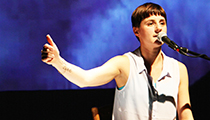This website uses cookies so that we can provide you with the best user experience possible. Cookie information is stored in your browser and performs functions such as recognising you when you return to our website and helping our team to understand which sections of the website you find most interesting and useful.
ED2014 News ED2014 Week1 Edition
A Fringe full of ventures Part 2: Forest Fringe
By Chris Cooke | Published on Wednesday 6 August 2014

Yesterday we remarked on how the Edinburgh Fringe is also a festival of cultural entrepreneurialism, resulting in a plethora of exciting cultural business ventures taking place in this city each August, albeit often in a slightly erratic and confusing manner. It’s this element of the Edinburgh Fringe that has resulted in there being not one, not two, but three free show strands at the Festival.
Though, when we say there are three free show strands – meaning the Free Fringe, Free Festival and the Freestival – that maths actually ignores another important programme within the wider festival that employs a pay-what-you-want philosophy. And that is the Forest Fringe. Though it operates in a very different way, and while the other free show collectives are best known for their comedy (though their programmes do go beyond that), the Forest Fringe is usually associated with other art forms.
“Forest Fringe is an artist-led organisation” the group’s Ira Brand (pictured) tells ThreeWeeks, “meaning we all have our own artistic practice as well as the curatorial and facilitating roles we take on when it comes to running a venue in Edinburgh. That’s really important to me, that we come at everything as artists as well as programmers or managers”.
The Forest Fringe, of course, began life at the Forest Café on Bristo Place. Though since that building has been reborn as Assembly Checkpoint, the Forest Fringe team have found a new home at the Out Of The Blue Drill Hall, a big space with lots of potential.
“We’re learning all the time about how to best make use of the Drill Hall” Brand tells us. “It’s such a beautiful and unique space, full of possibilities, but also of course limitations, so we have to think creatively about what we can make happen. We have a ‘studio’, where all our daytime shows take place, and then we use the main Drill Hall space for our evening programme once the sun goes down; because of the stunning glass ceiling we can’t make it dark in there artificially”.
“This year the evening programme is slightly different” she adds. “Rather than the same show every night we have programmed different pieces and events for one or two nights each, so there’s always something new on. We also have installations, residencies and one-off events happening around the building or out in Leith”.
In both its original and new home, the Forest Fringe programme has always been very eclectic, in terms of the genres it covers, and the performers it involves. “Gruelling” is how Brand describes the process of picking who to present. “When we are programming I al ways think a lot about balance – we want a programme that is ‘balanced’ in terms of artists we’ve worked with before and new relationships, of more established or younger artists, and, really importantly, an exciting mix of types of experience on offer for an audience”.
Once the programme has been selected, of course, all shows are then presented on a pay-what-you-want basis. “It’s vital for us that our shows are by donation. There are enough barriers to audiences engaging with theatre and performance, especially at the Fringe where there is such a vast amount of work on, so it’s really important as a way of encouraging people to take a chance on seeing something they are not familiar with”.
Though that ambition creates challenges, Brand admits. “I think the commercial side of the Fringe as a whole is tricky, it’s a huge financial commitment for artists to present their work here. Almost nobody expects to make money. And as an audience member it can be prohibitively expensive to see a lot of work. Of course it’s commercially tricky for us. We rely on a brilliant team of volunteers who give their time for free, on the artists who present their work for donations, and for us it’s always a massive labour of love”.
Since its conception in Edinburgh, the Forest Fringe has taken its approach way beyond Scotland, with the team working in Lisbon, Austin, Bangkok, San Francisco, Yokohama and Hong Kong. Meanwhile, back in Edinburgh, the whole endeavour has grown and matured, but hopefully without losing its adventurous spirit.
Brand first performed at the Forest Fringe in 2008, becoming a volunteer manager in 2011 and now a co-director. She says of the venture’s development over the years: “I think we’ve just got better, if that’s not too flippant or arrogant a thing to say! I mean better at doing what we do, with slightly more maturity and rigour, whilst maintaining the playful and spontaneous nature of Forest Fringe that made me want to be part of it in the first place”.
LINKS: www.forestfringe.co.uk






